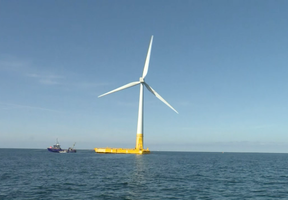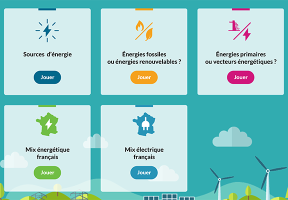Wind turbines, relaying wind strength
5 min read
Wind is a driving force that has long been used by mankind. To convert it into , we turn to wind . Thanks to high-tech components, wind turbines act like a real power station.

© - The wind turbine: a miniature power plant
Wind is generated by the uneven heating of the Earth’s surface, creating zones of different temperature and pressure: anticyclones and depressions. As pressure naturally seeks to find an equilibrium, air masses move from anticyclones toward depression zones. The bigger the depression, the stronger the wind.
Man has been using this strength for many years, to propel boats or drive windmills. Today, thanks to wind turbines, we can convert it into electricity.
Wind energy, speed and swept surface
Several principles govern wind turbine design:
- The power a wind turbine can produce is proportional to wind speed. The key is to ensure that the wind is constant and strong, at a height that avoids any disturbance caused by natural (relief, vegetation) or artificial (buildings, etc.) obstacles, and in clear, open spaces. That is why wind turbines are usually very tall (sometimes over 120 meters high), and located in open spaces, for example out at sea in the case of wind turbines. Offshore facilities - usually more than 10 km from the coast - are home to much bigger and more powerful wind turbines. They are often fitted with rotors measuring around 180 meters in diameter and have power outputs in excess of 10 MW. In May 2020, Siemens Gamesa (SGRE) even presented an offshore wind turbine with a 222-meter rotor and a power output of up to 15 MW.
- The power is proportional to the surface area swept by the turbine blades. There are usually three of them, and they form a propeller or rotor. Nowadays, the most common wind turbines in Europe have rotors measuring around 100 meters in diameter. Their power output is usually between 2 and 4 MW.
Wind turbine components: tower, rotor and nacelle
Wind turbines have three main parts:
- The tower ( ): its role is to support the other components (nacelle and rotor). Usually made of metal, it is fixed to a concrete foundation and anchored to the ground by long stakes. Offshore wind turbines are installed on the seabed using the same principle.
- The rotor: its role is to transform the wind’s (movement) into . It includes the nose cone and the propeller, which itself comprises three blades (less commonly, two). The blades are designed according to aerospace technologies and manufactured using composite materials (fiberglass- or carbon-fiber-reinforced polyester) that are light, rigid and resistant.
- The nacelle: located at the top of the tower, behind the rotor, it houses the generator that produces electricity using the mechanical force of the moving rotor. The energy is carried to the ground by electric cables running down the wind turbine tower. The installed power (power generation capacity) in a nacelle can reach 5 megawatts.
Wind turbines also have a system that serves to:
- Position the rotor perpendicular to the wind direction to harness the maximum driving force;
- Modify the angle of incidence of the blades relative to the wind, to maximize energy recovery.
Using this command-control system, the wind turbine can be stopped automatically and almost immediately if necessary. This ensures continuous operational safety.
Wind turbines - mini power stations
Wind turbines need a minimum wind speed of around 10-15 kilometers/hour to start up. They also have an upper speed limit of 90 kilometers/hour, sometimes more on some recent models. This limit meets both safety and profitability targets: when the parts rotate very fast, they wear out and weaken, for a relatively minimal gain in electricity production.
The rotation speed of the rotor (12 to 15 revolutions/minute) must be increased by an internal mechanical system, the gearbox, that can increase the speed to around 1,500 revolutions/minute, the speed required for the alternator to work correctly.
Electronic power converters adjust the frequency of the current produced by the wind turbine to match the electricity grid it is connected to (50 hertz in Europe), while enabling the wind turbine rotor to spin at variable speed according to the wind.
Connecting a wind turbine to the grid
The electric voltage produced by the alternator – around 600 to 1,000 volts – is increased by means of a power converter located inside the nacelle or tower, up to 20,000 or 30,000 volts. This level of voltage is enough to carry the electricity to the electric grid connection point (GCP). For wind power plants with a capacity of 10-15 megawatts, the connection voltage level in France is usually 20,000 volts. For larger power plants, the connection voltage can reach 60,000 to 90,000 volts, and sometimes even 225,000.




















